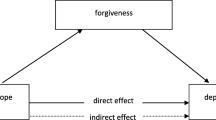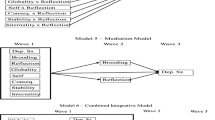Abstract
The hopelessness theory of depression hypothesizes the existence of a hopelessness subtype of depression, characterized by its specific cause, symptoms, course, therapy, and prevention. Data from depressed inpatient adolescents (N = 160) were used to evaluate (a) the relation between hopelessness and the hypothesized symptoms of hopelessness depression; and (b) the latent structure of the relation between hopelessness and the symptoms of hopelessness depression, to test for a hopelessness depression taxon (i.e., subtype). Results suggest that hopelessness was related to the hypothesized symptoms of hopelessness depression, treated singly and in combination. However, results from the application of Meehl and Yonce's (1994) MAMBAC taxometric analytic procedure, using hopelessness and the symptoms of hopelessness depression as taxonic indicators, did not support the existence of a hopelessness depression latent taxon. These results suggest that hopelessness depression may best be conceptualized as a dimension or continuum versus a category or subtype.
Similar content being viewed by others
REFERENCES
Abramson, L. Y., Alloy, L. B., & Metalsky, G. I. (1995). Hopelessness depression. In G. M. Buchanan & M. E. P. Seligman (Eds.), Explanatory style (pp. 113–134). Hillsdale, NJ: Erlbaum.
Abramson, L. Y., Metalsky, G. I., & Alloy, L. B. (1989). Hopelessness depression: A theory-based subtype of depression. Psychological Review, 96, 358–372.
Abramson, L. Y., Seligman, M. E. P., & Teasdale, J. (1978). Learned helplessness in humans: Critique and reformulation. Journal of Abnormal Psychology, 87, 49–74.
Alloy, L. B., & Clements, C. M. (1996). Hopelessness theory of depression: Tests of the symptom component. Manuscript submitted for publication.
Alloy, L. B., Hartlage, S., & Abramson, L. Y. (1988). Testing the cognitive diathesis-stress theories of depression: Issues of research design, conceptualization, and assessment. In L. B. Alloy (Ed.), Cognitive processes in depression (pp. 31–73). New York: Guilford Press.
American Psychiatric Association. (1987). Diagnostic and Statistical Manual of Mental Disorders (3rd ed., revised). Washington, DC: Author.
Barrera, M., & Garrison-Jones, C. V. (1988). Properties of the Beck Depression Inventory as a screening instrument for adolescent depression. Journal of Abnormal Child Psychology, 16, 263–273.
Beck, A. T., Rush, A. J., Shaw, B. F., & Emery, G. (1979). Cognitive therapy of depression. New York: Guilford Press.
Beck, A. T., & Steer, R. A. (1987). Beck Depression Inventory manual. San Antonio: Harcourt Brace Jovanovich.
Beck, A. T., Weissman, A., Lester, D., & Trexler, L. (1974). The measurement of pessimism: The Hopelessness Scale. Journal of Consulting and Clinical Psychology, 42, 861–865.
Brown, G. W., & Harris, T. (1978). Social origins of depression. London: Tavistock.
Cohen, J., & Cohen, P. (1983). Applied multiple regression/correlation analysis for the behavioral sciences (2nd ed). London: Lawrence Earlbaum.
Haaga, D. A. F., Dyck, M. J., & Ernst, D. (1991). Empirical status of cognitive theory of depression. Psychological Bulletin, 110, 215–236.
Haslam, N., & Beck, A. T. (1994). Subtyping major depression: A taxometric analysis. Journal of Abnormal Psychology, 103, 686–692.
Hayes, S. C., Nelson, R. O., & Jarrett, R. B. (1987). The treatment utility of assessment: A functional approach to evaluating assessment quality. American Psychologist, 42, 963–974.
Kazdin, A. E., Rodgers, A., & Colbus, D. (1986). The Hopelessness Scale for Children: Psychometric characteristics and concurrent validity. Journal of Consulting and Clinical Psychology, 54, 241–255.
McCranie, E. W., & Riley, W. T. (1992). Hopelessness and persistence of depression in an inpatient sample. Cognitive Therapy and Research, 16, 699–708.
Meehl, P. E. (1995). Bootstraps taxometrics: Solving the classification problem in psychopathology. American Psychologist, 50, 266–275.
Meehl, P. E., & Golden, R. R. (1982). Taxometric methods. In P. C. Kendall & J. N. Butcher (Eds.), Handbook of research methods in clinical psychology (pp. 127–181). New York: John Wiley & Sons.
Meehl, P. E., & Yonce, L. J. (1994). Taxometric analysis: I. Detecting taxonicity with two quantitative indicators using means above and below a sliding cut (MAMBAC procedure). Psychological Reports, 74, 1059–1274.
Metalsky, G. I., Joiner, T. E., Hardin, T. S., & Abramson, L. Y. (1993). Depressive reactions to failure in a naturalistic setting: A test of the hopelessness and self-esteem theories of depression. Journal of Abnormal Psychology, 102, 101–109.
Overholser, J. C., Adams, D. M., Lehnert, K. L., & Brinkman, D. C. (1995). Self-esteem deficits and suicidal tendencies among adolescents. Journal of the American Academy of Child & Adolescent Psychiatry, 34, 919–928.
Robinson, N. S., Garber, J., & Hilsman, R. (1995). Cognitions and stress: Direct and moderating effects on depressive versus externalizing symptoms during the junior high school transition. Journal of Abnormal Psychology, 104, 453–463.
Spangler, D. L., Simons, A. D., Monroe, S. M., & Thase, M. E. (1993). Evaluating the hopelessness model of depression: Diathesis-stress and symptom components. Journal of Abnormal Psychology, 102, 592–600.
Spirito, A., Williams, C. A., Stark, L. J., & Hart, K. J. (1988). The Hopelessness Scale for Children: Psychometric properties with normal and emotionally disturbed adolescents. Journal of Abnormal Child Psychology, 16, 445–458.
Whisman, M. A., Miller, I. W., Norman, W. H., & Keitner, G. I. (1995). Hopelessness depression in depressed inpatients: Symptomatology, patient characteristics, and outcome. Cognitive Therapy and Research, 19, 263–284.
Author information
Authors and Affiliations
Rights and permissions
About this article
Cite this article
Whisman, M.A., Pinto, A. Hopelessness Depression in Depressed Inpatient Adolescents. Cognitive Therapy and Research 21, 345–358 (1997). https://doi.org/10.1023/A:1021830600946
Issue Date:
DOI: https://doi.org/10.1023/A:1021830600946




